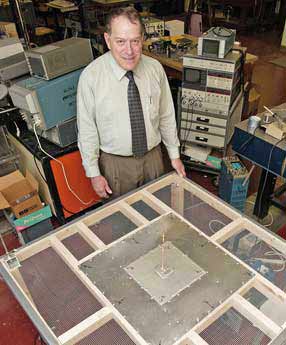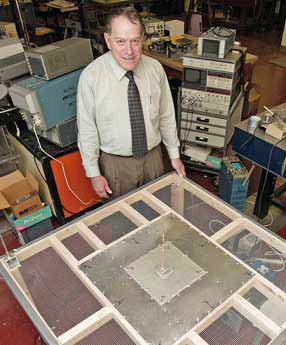 KINGSTON, R.I. –August 31, 2007— A bit of the University of Rhode Island may soon be riding in automobiles, thanks to Rob Vincent, an employee of URI’s Physics Department.
KINGSTON, R.I. –August 31, 2007— A bit of the University of Rhode Island may soon be riding in automobiles, thanks to Rob Vincent, an employee of URI’s Physics Department.
All those hours Vincent spent tinkering in the basement while his parents peered down the stairs wondering what on earth he was doing are beginning to reap benefits. All that wire he used to wrap abound the family’s home to see if he could get better reception for his amateur radio is also paying dividends.
First, the U.S. Patent Office awarded him a patent for his system and method for providing a distributed loaded monopole antenna with all 29 of its claims (or applications) earlier this year. The patent is pending in several foreign countries.
Then the Lear Corporation, ranked 130 among Fortune 500 companies, licensed six of those applications, which are now in development. Lear is one of the world’s largest suppliers of automotive interior systems and components.
“This technology will allow us to provide greater distance and improve performance for tire pressure monitoring, remote keyless entry, remote start, as well as comfort and convenience features to our customers,” commented Mike Fawer, Lear’s vice president of engineering.
The terms and conditions of the agreement between the URI Foundation and the Lear Corp. are confidential.
“This is the kind of innovation we want the University and its faculty and staff to bring to the market,” said URI President Robert L. Carothers. “With the establishment of a research foundation, which was passed by the General Assembly and signed into law this July, the University will be able to optimize the commercialization of such intellectual property.”
Vincent has accomplished what others said was impossible – he shrunk the antenna while maintaining its efficiency and bandwidth.
Not one to rest on his antenna laurels, the inventor is devising ways to shrink the two-dimensional DLM antennas, also known as the plano-spiral DLM antennas, by using thin film and monolithic techniques.
The maximum frequency of operation at this time exceeds 1,000 megahertz, which has applications for cell phone, wireless communications, and radio frequency identification. Vincent’s goal is to go even smaller with applications into the to 5,000 megahertz frequency range.
He is working with Vishay Electro Films, Inc. of Warwick, Rhode Island to develop the thin film antenna. Currently, the line widths of the 1,000-megahertz antenna are .016 of an inch thick and approximately one inch in length. To get to 5,000 megahertz, the antennas will have to be much smaller. Vishay can make antennas with a line resolution to less than 10 microns (one micron equals .039 of a thousand of an inch.)
“Rob is a pleasure to work with, “says Phil Fabis, research and development manager at Vishay. “He takes an old school approach, sits down with a pen and paper to work things out. Nothing deflates his balloon, it’s the end goal he’s interested in, not the route.”
Vincent was jobless when he came to URI in the early ‘90s with the intention of finishing his bachelor’s degree after more than 30 years working in electronics and design engineering for companies such as Raytheon Co. He was hired as a technician in the University’s Physics Department repairing and designing research equipment and assisting graduate students and faculty members.
Under an agreement Vincent signed with the URI Foundation, URI will receive 40 percent of any commercial profits of these licensed inventions, Vincent will receive 40 percent, and 20 percent will go support to student scholarships in URI Physics Department.
Vincent now works out of an empty turf barn on the edge of the University’s campus, preparing proposals, prototypes, and reports related to his inventions.
Vincent also has several other patents pending, including variations of the DLM antenna technology. In addition, the inventor is working on some completely new technology in the field of communication.

